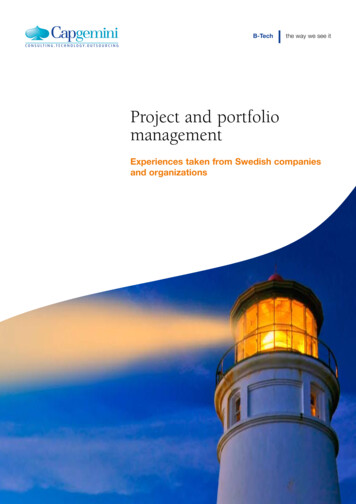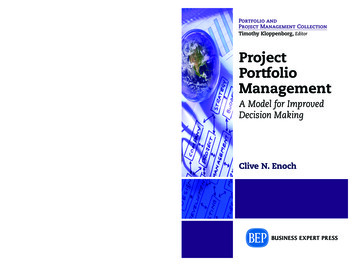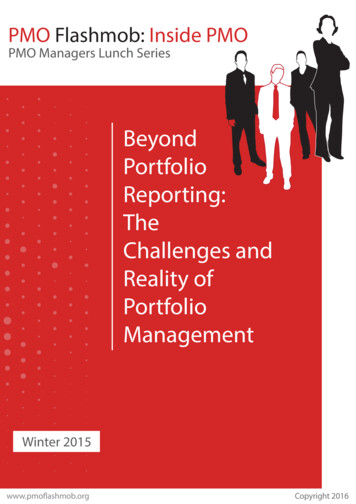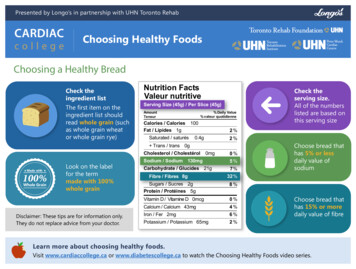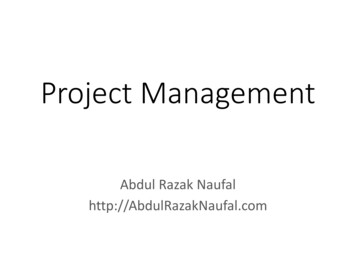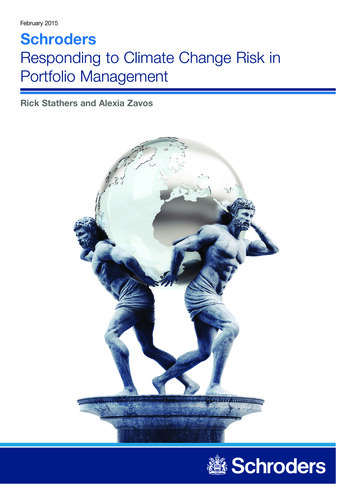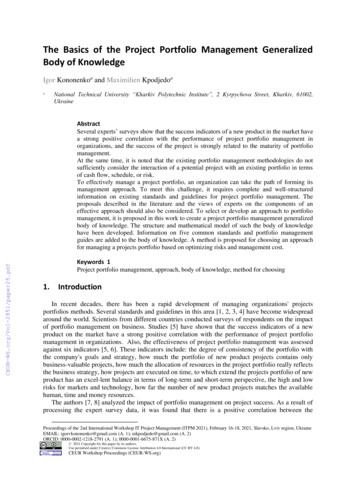
Transcription
Project and Portfolio ManagementChoosing your Weapon: Software Tools Altran March 2019
1. IntroductionToday, more and more project managers are getting involved in selecting projectmanagement software tools.Which makes sense – after all, project managers are the people who will use the producton a daily basis. They will also have strong views about what the software should do andhow it can help them manage their projects.If you as a project manager are choosing new software for the team, what should you belooking for?This paper will propose you some guidance in terms of parameters, context and expectedvalue.It does not aim to point you towards a specific software suite or supplier. There are manytools that you can find and test on-line, our objective is to help assess your situation as inorder to define the most adapted tool framework to suit your own business case.2. Tool selection : the 3-concept prismProjects are increasing in complexity, in terms of scope, requested skills, geography, multifunctional integration, etc. This induces a fine tuning and monitoring of main quantitativedata such as activities planning, resourcing and costs, facilities The need for a tool that supports (all along the project life cycle) the management of scope,costs, resources, facilities, can be already impactful at the first steps of projectmanagement process.We shall highlight the main selection criteria for choosing the most adapted tool to a givensituation and business. Keep in mind that these criteria are always to be filtered throughthe prism of three concepts :The tool or software / The people or users / The processes or methodologies .To start, ask yourself three basic questions : How would your resources apply the adequate processes without an appropriate tool ? What is the added value of the most powerful tool, if you did not implement theappropriate processes ? How will we apply the best processes in the most adapted tool if your resources are nottrained efficiently ?In the next chapter, we will list the most important criteria and cover these questions youand the main stakeholders in your organization) must address.altran.com
3. Recommended approachSelecting the right project management software suite starts with a clear, honestassessment of your current situation (As is: what are my problems?) and targetedsituation (To Be: what do I need to address ?).Think about what needs to be covered: plan, resource, costs, facilities, risks So, before listing the criteria for choice, ensure that you ask and address all thequestions below : What are your current issues ? This is the As Is analysis What is the expected added value in the future ? This is the To Be analysis What will we need to implement and change to reach the targeted situation ?This is the Gap analysisSome examples of expected added value : Improve time to market by implementing an efficient and accurate monitoringof the project’s progress Ability to share alerts in real time and generate workarounds Manage the risks efficiently through registers and heat mapsChallenge yourself:, it is only human to stack more and more functionalities in therequirements, even if you will end not using half of them So ask you the right question: what is necessary AND sufficient ?Learn how to distinguish the Nice to Have from the Need to Have.Is your Top Management fully committed to this initiative ? In direct liaison withthe change management aspects, the positive signal from top managementcommitment will help the organization allowing for harmonious change, whereasthe reverse situation might induce strong drawbacks, reluctance, delays Ensure you on-board all the key stakeholders, not only those who will benefitfrom the tool, but also those who will save data into it. Could you imagine thedesign of a tool without discussing with the end users ?Are your processes correctly assessed ? Keep in mind that the tool will supportthe given processes, so you need them to be fully understood and applied withinthe organization. If necessary, perform a full review of all your processes withyour key stakeholders, including especially those who handle these processes ona daily basis.Once you have addressed all these points, you can define accurately your list ofcriteria (business, technical, users, )altran.com
3. Criteria for an optimal choiceHere below is a list of criteria that is not exhaustive,but can be used as a first guideline.Some are more or less related to the aspects of software or processes or users.Answering these topics in a consistent manner will lead you to an accurate image of theenvisaged tool and its requested functionalities.In a first phase, think about what needs to be covered and draft a list:plan, resource, costs, facilities, risks, multilevel portfolio-project What is granularity level required: i.e. the level of detail you want to manage in the tool. Example 1 : will you track planned and actual time per individual resource or only at theskill type level ? Example 2 : to which level of detail will you track the progress of activities in terms ofworkload, duration, ?User friendliness and intuitive aspects : the more tool is user-friendly, the better inperformance and acceptance. It is recommended to involve key users when testing somepre-selected tool candidates.Access rights and user types : who will use the tool ? Involve the appropriate users anddefine the main user types. Keep in mind the user type also defines the access rights.Costs : in addition to the price itself, consider the business model of your provider. Theservice can be sold as a time-based fee or be based on a cost per user and per user type.In this last case, assess carefully the number of licenses for Administrator, Portfoliomanager, Function manager which are usually the most expensive licenses.Ability to customize : will you require specific views, specific modules, specific workingcalendars, specific granularity, ? The tool, by its ability to customize, will need toaddress these questions.Security : be clear on what you expect in terms of security, especially knowing thatproviders will increasingly propose you with a cloud-based solution, in SaaS (centralhosting) mode.Generate timesheets and provide reporting (resource management aspects): will you needto track the time of individuals or teams. ? If the answer is yes, then the tool will have toensure an interface with the time management module.Cost management : will you manage costs in the tool (costs of resourcing or externalcosts, CAPEX or OPEX) ? If yes, ask about the possibility for the tool to interface with anERP environment, that could simplify your cost management processes.altran.com
Training materials : you will need training materials for the hardware part of the tool (nonchangeable part and functionalities) as well as for the customized part of the tool. Kits peruser types will need to be requested.Integration of multi functions : usually, not only one but several functions interact in a sameplanning, from several sites. You need to ensure that the activities of each part are linkedconsistently in terms of duration, efforts, granularity, as the project plan requires. This notionof integration is crucial at the project management level.Integration of multi-levels : Will a simple project approach be sufficient ? Will you need tomeasure only the value delivered by your projects or will you also require a reporting morealigned to organization’s strategy, in terms of performance, risks, resourcing, ? In thiscase, the ability for the tool to manage program-portfolio levels and generate the adequatereporting, will be needed.Integration to other tools : We mentioned interfacing to ERP tools, but not only a Financedriven purpose might explain this functionality. The diversity of functions involved on a givenproject also induces a diversity of tools that can be used. So the trend to communicate withthird-party software will increase and you will need to integrate the diverse and sometimescomplex constellation of tool touch points within your own organization.4. Capturing information and generating dataHere we consider two aspectsVisual quality of the reporting : very powerful tools can be poor in terms of generatingdashboards and other reporting figures. Be careful on this topic ! Request demos from theprovider with your own data. SaaS solutions tend to be best adapted to these needs.Reliability of the data : remember that the quality and reliability of the reporting is directlylinked to several concepts that you intuitively can apprehend: The quality of the data entered by the end users The accuracy of these data The granularity consideredOnce you addressed these 3 topics, consider the periodicity of the update process: the moreoften you update your data, the more reliability you gain in your reporting.altran.com
5. Implementing and managing the changeMake sure your organization is ready to take on a new solution.Have you measured the change management aspects ? Project management software is notjust for the project manager, it impacts all stakeholders. These groups may be reticent to usenew tools and practice new processes, so do not underestimate the inertia of individualhabits.We strongly recommended that you set up a regular and accurate communication to all stakeholders, during the wholeapproach. define an approach on how the users will be initiated to the tool, get training and get usedto the new tool as a project manager, be a strong key user and be an example towards your team6. ConclusionRemember the three concepts : People, Processes and Tool. How would your resources apply the adequate processes without an appropriate tool ? What is the added value of the most powerful tool be impacted, if you did not implementthe appropriate processes ? How will we apply the best processes in the most adapted tool if your resources are nottrained efficiently ?Capture all criteria with your key stakeholders and ensure all of these criteria are assessed.Think multi-level: various needs should be addressed by the tool in terms of data reported,according to the respective governance levels.Challenge yourself in the choice of functionalities when writing your requirements. Mostfrequently we request more than we actually need.altran.com
7. SourcesHans van Dijk : Project Management tool selection process in Arcelor Mittalhttps://twitter.com/hans hpe/status/731061719888494592?lang er also to the sites of most cited tools for project – portfolio management (thisshort list is not exhaustive) Planisware – v6Oracle – PrimaveraMicrosoft Project on ServerJiraProject management.comWrikeSmartsheetMagic Quadrant (see Gartner example below) can also be a good guide forrespective positioning of tools in a grid based on given folio-management-worldwide.htmlaltran.com
8. About the authorJean-Eric Ancel is an expert consultant for Altran Switzerland since 2014.He has a scientific background (PhD and post doc in Life Sciences chemistry) and has over 25 yearsexperience as a project leader, manager, planner and portfolio manager for the full value chain ofpharmaceutical development.He has worked for leading pharma and medical device companies such as Sanofi, Pasteur, Roche,JnJ, UCB, Ferring, Jean-Eric is PMP and PfMP certified at the PMI, and is a member of the Switzerland chapter.Linked In : https://www.linkedin.com/in/anceljeaneric/Altran ranks as the undisputed global leader in Engineering and R&D services (ER&D), followingits acquisition of Aricent.The company offers clients an unmatched value proposition to address their transformation andinnovation needs. Altran works alongside its clients, from initial concept through industrialization,to invent the products and services of tomorrow.For over 30 years, the company has provided expertise in life sciences, aerospace, automotive,defense, energy, finance, railway and telecommunications. The Aricent acquisition extends thisleadership to semiconductors, digital experience and design innovation. The Altran Groupgenerated revenues of 2.916 billion in 2018, with some 47,000 employees (300 in Switzerland)in more than 30 countries.altran.com
Refer also to the sites of most cited tools for project - portfolio management (this short list is not exhaustive) Planisware - v6 Oracle - Primavera Microsoft Project on Server Jira Project management.com Wrike Smartsheet Magic Quadrant (see Gartner example below) can also be a good guide for
